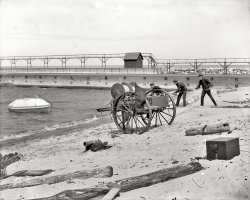
MAY CONTAIN NUTS

Search Shorpy
SHORPY ART

Framed or unframed, desk size to sofa size, printed by us in Arizona and Alabama since 2007. Explore now.
Join and Share
Ad-Free Shorpy
Shorpy is funded by you. Patreon contributors get an ad-free experience.
Learn more.

Recent comments
- Baldwin 62303
- Baldwin VO-1000
- Cold
- No expense spared
- Tough Guys
- Lost in Toyland
- And without gloves
- If I were a blindfolded time traveler
- Smoke Consumer Also Cooks
- Oh that stove!
- Possibly still there?
- What?!?
- $100 Reward
- Freeze Frame
- Texas Flyer wanted
- Just a Year Too Soon
- WWII -- Replacing men with women at the railroad crossing.
- Yes, Icing
- You kids drive me nuts!
- NOT An Easy Job
- I wonder
- Just add window boxes
- Icing Platform?
- Indiana Harbor Belt abides
- Freezing haze
- Corrections (for those who care)
- C&NW at Nelson
- Fallen Flags
- A dangerous job made worse
- Water Stop
Member Photos
The Shorpy
Print Emporium
Print Emporium
Search Shorpy
Search results -- 30 results per page
- Chapel Hill: 1939
- Fourth of July 1939 near Chapel Hill, North Carolina. "Rural filling stations become community centers and general loafing ... uniforms say "Cedar Grove" which is a tiny crossroads north of Chapel Hill in Orange County, NC--Closer to Hillsborough.
Poor RC ... Posted by Dave - 07/30/2012 - 2:40pm -
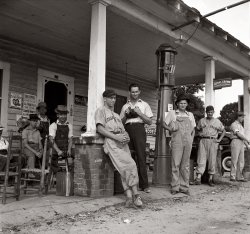
- Runt's Pool Parlor: 1939
- ... advertising Tobacco Ball in window. Zebulon, Wake County, North Carolina." Acetate negative by Marion Post Wolcott. View full size.
Not ... Posted by Dave - 04/11/2021 - 1:19pm -
![Runt's Pool Parlor: 1939 November 1939. "Runt's pool parlor with poster advertising Tobacco Ball in window. Zebulon, Wake County, North Carolina." Acetate negative by Marion Post Wolcott. View full size.
Not a pool hall anymore
Alias George E StoneLooks like the sort of place Boston Blackie might wander into.
Possible Location
With a capital T and that rhymes with PTrouble right here in River City ...
Any Boob... can take and shove a ball in a pocket. And they call that sloth.
The first big step on the road to the depths of degradation.
I say, first, medicinal wine from a teaspoon, then beer from a bottle.
And the next thing you know, your son is playin' for money in a pinch-back suit.
Back Door DeliveryShiny clean rear of 1937 or '38 Chevrolet Sedan Delivery reflected in window.
I am confused by the cigarette advertising slogan on the vehicle door. Is it on the car or reflected from somewhere?
[Yes. - Dave]
Hope it was a 3 window coupe!The Tobacco Ball signage certainly drew my attention. The prospect of winning a free FORD V8 would undoubtedly have convinced me to attend.
And mosquitoes tooJudging from the size of the mesh on the screen door they must have pretty big flies in North Carolina.
Window letteringWhen I was a young sign painter, soft drink companies and breweries had healthy budgets for what is now called "point of purchase" advertising. Back then this was called "privilege panels". The beverage companies supplied the preprinted signs which usually had a blank panel to personalize the store.
Window valences were water decals applied to the interior of the glass.
If the store or tavern moved a lot of product, the salesman may allot extra for some custom lettering (Runts Pool Parlor), but not always.
If your company was able to service an account like this, you were assured of steady, although not very profitable work. As a young apprentice I was often given these jobs. Perfect environment to learn layout and speed
Runt"Runt" was probably about 6-foot-8 and weighed about 350 pounds. They had to have the double doors on the front so he could get in and out of the place.
Pine State Ice CreamWhat was being advertised by that 'Pine State' sign reflected in the window?
Eureka! Pine State Ice Cream from the Pine State Creamery in Raleigh. The brand is gone, but the building, built in 1928, is on the National Register of Historic Places.
(The pine is the official state tree of North Carolina, but Maine is officially the Pine Tree State.)
Check the 7up signnow count the bubbles.
Dental recordsThere's a reflection in the window of a sign for Dr. Massey, Dentist. He appears to have had a solo practice until his niece Zyba Massey joined him in 1954, after becoming the first female to graduate from the UNC dental school.
https://dentistry.unc.edu/2004/02/zyba-massey-first-female-graduate-of-u...
(The Gallery, M.P. Wolcott, Small Towns)](https://www.shorpy.com/files/images/SHORPY-8c35797a.thumbnail.jpg)
- Cottage Chic: 1936
- Circa 1936. "Georgetown. Georgetown County, South Carolina. Small houses, Series 2, Mansfield's Quarters." What this place lacks ... was too sandy to support grass.
Yard theory I'm in North Carolina, but I've been told by a centenarian or two around here that in ... Posted by Dave - 05/29/2013 - 11:59pm -
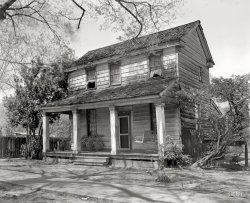
- King Street: 1910
- Charleston, South Carolina, circa 1910. "King Street looking north." Detroit Publishing Co. glass negative, Library of Congress. View full ... Posted by Dave - 07/19/2012 - 4:30pm -
![King Street: 1910 Charleston, South Carolina, circa 1910. "King Street looking north." Detroit Publishing Co. glass negative, Library of Congress. View full size.
Beth Israel SynagogueThe tall building on the left is, I believe, Beth Israel Synagogue, built around 1911.
[As noted above this is not a synagogue but rather the Hirsch, Israel & Co. department store. - Dave]
King StreetWhat a wonderful photo -- so much to look at. Charleston has done an amazing job keeping many of these buildings intact -- King Street is still a posh shopping district with many of these buildings now housing Ralph Lauren and the like, but with many of the original details of the facades intact. The church in the middle distance is St. Matthew's Lutheran Church, a landmark building.
Another awesome pictureI love the details, and this snapshot of life in those days. The outfits, the young men hanging on the corner watching the pretty girls go by. The woman in back in white, while most of the other women are in black. And the hats, I love the hats.
LightsAll those stringed lights! I'd hate to be the one that had to change out all those bulbs!
SignsI just love this picture. Not only the clothing, but all the signs as well. Being the owner of a sign shop, this gives me a lot too look at. Wish there was a favorites button I could add this to.
A Clean SweepLazarus' hardware store seems to be especially devoted to brooms. Judging from the amount of horse droppings on the street, I bet they came in handy.
From Clutter to ArtWhat a wonderful photo; I'll add my "yea" to the chorus of approbation. The signs, which might have been eyesores to folks at the time, are now like individual pieces of street art.
253 King Street TodayThe Beth Israel synagogue seems to be gone. Can't find any info online about what happened to it, though.
King StreetThis incredible image of King Street in 1915 (original file) can be found at the LOC site.
http://hdl.loc.gov/loc.pnp/det.4a24156
There is an ucompressed 30 mb scan (tiff format) of the original glass negative. I have downloaded it and tried my best in Photoshop to reproduce what you see here on Shorpy, but no luck. Any ideas on how to clean up the original from LOC like they did here?
["They" would be me. I used the Shadows & Highlights filter to get the image you see here. - Dave]
Hirsch, Israel & Co.The tall domed structure is the tower of the Hirsch, Israel & Co. department store, not a synagogue, on the corner of King and Wentworth streets.
+95Below is the identical view taken in May of 2010 from Hasell (pronounced HAZEL) Street.
Kerrison's Dry Goodsis still there 100 years later.
King Street Then & NowI love this photo as well because in 1905, my father's family owned a shop in #255 which is the building on the very left side of this image - the Jewelry Store under the clock.
I also had a friend photograph the street from the same angle in July 2011 and here is my own "Then & Now" interpretation.
Deborah
(The Gallery, Charleston, DPC)](https://www.shorpy.com/files/images/4a24156u.thumbnail.jpg)
- Country Store: 1939
- ... tobacco sharecropper at country store. Person County, North Carolina." The rustic emporium seen earlier here and here . ... for tobacco products on the building. As a North Carolinian, I am acutely aware of the impact of the golden leaf on our ... Posted by Dave - 11/16/2012 - 12:39pm -
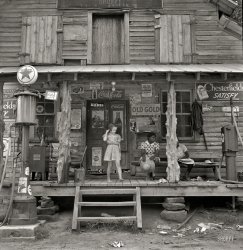
- The Orphanage: 1900
- Charleston, South Carolina, circa 1900. "Charleston orphan house." 8x10 inch dry plate glass ... was changed to Oak Grove, the facilities were moved to North Charleston and non-orphaned, emotionally disturbed children were accepted ... non-profit Carolina Youth Development Center located in North Charleston.
Scarred for life As if being an orphan wasn't hard ... Posted by Dave - 06/16/2011 - 2:18am -
![The Orphanage: 1900 Charleston, South Carolina, circa 1900. "Charleston orphan house." 8x10 inch dry plate glass negative, Detroit Publishing Company. View full size.
Torn downThe Charleston Orphan House was established by City Ordinance in 1790, making it the oldest municipal orphanage in the United States.
The Charleston Orphan House was charged with accepting all such poor orphan children, and children of poor distressed or disabled parents, as shall be deemed proper objects of admission by the Commissioners…The Commissioners of the Charleston Orphan House were elected each October by City Council. Additionally, the City provided annual appropriations for the running and maintenance of the facility.
In 1951, the Orphan House property on the corner of Calhoun and St. Philip Streets in downtown Charleston, was sold and the Orphan House itself was demolished. The mandate of the Orphan House changed somewhat at this time. The name was changed to Oak Grove, the facilities were moved to North Charleston and non-orphaned, emotionally disturbed children were accepted as residents. In 1978, the City removed itself from the direct involvement with the Oak Grove facility. Oak Grove became the private, non-profit Carolina Youth Development Center located in North Charleston.
Scarred for lifeAs if being an orphan wasn't hard enough, growing up in THIS place probably provided much fodder for psychiatric couches.
A nice cheery place to grow upJust another of the perks enjoyed by orphans one hundred years ago.
1865 to 1900The only real change between this image and the one from 1865 is the Yankees have gone home.
Behave!Be nice little kiddies now, or the gryphons will get you!
Calhoun & St. PhilipIf indeed that building was exactly at the corner of Calhoun and St. Philip, it means it was either on the grounds of the College of Charleston, or just across the street from it. So not only were you and orphan in that creepy building, but you got to look out of the gates every day and see the young southern gentleman scholars living the gentile life.
[Oy. - Dave]
"Excellent!"This looks like a real-life representation of the mansion of C. Montgomery Burns.
Little Orphan AnnieNo wonder her eyes were blanks.
SpookyLike something out of Edward Gorey!
But where's the fantod?
Present day imagesHere are two images of the former location of the orphanage. The site is actually across the street from the College of Charleston. The building In the background of the street image and in the aerial image, the tall building just below right center is the Francis Marion Hotel.It is across the street from Marion Square which was the grounds of the old Citadel.The orphanage was located in the center of the aerial image
The beautiful old orphanage was torn down for the sake of a Sears parking lot. The statue on the top, "Charity," and the bell are in the Charleston museum.
View Larger Map
View Larger Map
(The Gallery, Charleston, DPC, Kids)](https://www.shorpy.com/files/images/4a08846a.thumbnail.jpg)
- Forty Winks: 1940
- ... it was for many people, not all that long ago.
Drove North, still found segregation Although the state abbreviation is cut off in ... featured "OCTOBER 31 40" across the bottom are from South Carolina. According to this site the plates were black over yellow.
... Posted by Dave - 09/04/2012 - 2:09pm -
![Forty Winks: 1940 June 1940. Washington, D.C. "Negro driver asleep under a truck. There are no sleeping accommodations for Negroes at this service station on U.S. 1." Photo by Jack Delano for the Farm Security Administration. View full size.
I Think I'dPut chocks around those wheels.
FrühaufsteherWhat's the significance of FRUEHAUF (German for "up early") on the back of the truck?
[The trailer was manufactured by the Fruehauf Corporation. - tterrace]
Smart ManThis tired soul appears to have done the best with what he had to work with. He's under the truck for shade, using a bag of whatever he was hauling as a pillow and a small tarp to lay on instead of the hot, dirty, rock hard ground. Young drivers of modern day wouldn't know how to survive without the super size sleeper, GPS, internet hook-up, power this and that, satellite TV, air ride seats etc.
Green BookThe Negro Motorist Green Book, 1949 edition, is actually online here, and you can see how bad it was for many people, not all that long ago.
Drove North, still found segregationAlthough the state abbreviation is cut off in the photo, the only 1940 state license plates I'm aware of that featured "OCTOBER 31 40" across the bottom are from South Carolina. According to this site the plates were black over yellow.
Some years ago I read one of Peter Egan's "Side Glances" columns in Road & Track in which he described finding a 1950s-era road atlas designed specifically for black travelers. The atlas was designed to help the traveler deal with finding food, fuel and lodging in a segregated America. Sad to think such a publication had to exist, and that the driver pictured may have benefited from it. (Edit: Thanks auntjess for finding that!)
This photo serves to remind us that the nation's capital was once a Southern city in more ways than one.
A Permanent RestAs I truck driver I can sympathize with this guy--it's very uncomfortable to have to sleep in your seat. Having said that, it beats dying. The trucks of that era had one air tank for their brakes, if they even had air brakes at all. If it started to creep then I hope this man had some serious yogi skills to survive being crushed. Hopefully he had the good sense to chock one of the front wheels. I would have opted to sleep on the end of the flatbed.
Pillow talkThe fella looks like he is using a bag of grain for a pilla. Times they were tough. WOW!
Old Army trickThis reminds me of an old US Army trick my godfather told me about when I was young.
Setting up your sleeping gear under your vehicle so if anyone else comes driving in during the night you won't end up getting run over because they don't see you.
(The Gallery, Cars, Trucks, Buses, D.C., Jack Delano)](https://www.shorpy.com/files/images/SHORPY_8a34404a.thumbnail.jpg)
- Open House: 1936
- ... Circa 1936. "Dormered cabin. Georgetown County, South Carolina." This is the kind of place the real estate listings describe as ... the war. The stark contrast of photos from Washington DC north cataloged by Shorpy tells the story very clearly. Pictures are indeed ... Posted by Dave - 08/18/2013 - 10:39am -
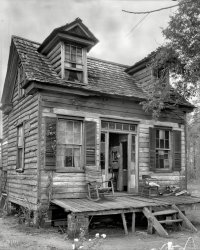
- Box Car: 1940
- ... May 1940. "Outside of the tobacco warehouses in Durham, North Carolina." 35mm nitrate negative by Jack Delano for the Farm Security ... Posted by Dave - 05/02/2022 - 9:40am -
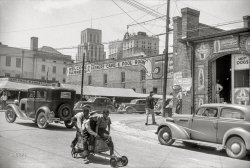
- The Unknown Scrummers: 1920
- ... These six home games were:
October 2: 14-7 loss to North Carolina State
October 9: 12-7 defeat of Lafayette
October 16: 7-2 defeat ... Posted by Dave - 08/04/2012 - 3:11am -
![The Unknown Scrummers: 1920 Washington, D.C., or vicinity circa 1920. The caption just says "football." Who can identify the venue? Harris & Ewing Collection glass negative. View full size.
Mother BIsn't that Bancroft Hall at the U.S. Naval Academy in Annapolis?
Narrowing it downNavy played six home games in 1920, compared to just one road game (a 14-0 loss at Princeton) and their traditional neutral-site game against Army at the Polo Grounds in New York (a 7-0 victory.) These six home games were:
October 2: 14-7 loss to North Carolina State
October 9: 12-7 defeat of Lafayette
October 16: 7-2 defeat of Bucknell
October 30: 47-0 defeat of Western Reserve
November 6: 21-6 defeat of Georgetown
November 13: 63-0 defeat of South Carolina
[This could have been taken anytime from 1910 to the early 1920s. - Dave]
Next to BancroftOn the left it's either the Seamanship Building or the Armory on the Naval Academy campus. As this 1919 panorama shows, they were already bookends of Bancroft Hall and its yards. They're now known as MacDonough and Dahlgren Halls.
Go Navy!It's Bancroft, indeed.
The shot is taken from the football field (now basically just a track), looking back at the "T" section of the rear wing of the dorm in the upper-left (which now has a 2-story walkway connecting it to the main building).
http://www.bing.com/maps/?v=2&cp=qgxdyn8mssvt&scene=25283264&lvl=1&sty=b
Beat Army!Swein is close, but I think you're on the wrong side of Bancroft. This shot is at Thompson Field, where Navy played their football games before the Navy-Marine Corps Memorial Stadium was built in 1959. It was situated where LeJeune Hall (the pool) and the 8th Wing of Bancroft stand today. The buildings seen in this picture are, I believe, the 6th Wing of Bancroft and, to the left, just the corner of Dahlgren Hall.
Love the stitched-on number patches. Would be interesting if anyone could figure out which game this was. The helmet "technology" seems to place it somewhere in the teens or '20s.
Back in the dayPeople talk about how violent the sport is today, but the 1909 football season saw 26 deaths on both college and professional teams during the regular season. This was more than double that of the 1908 season.
Navigation, please!!The photo is of Bancroft Hall at Annapolis but it's taken from due south of the campus. The corner of Dahlgren Hall is just showing to the far left and the sixth wing of Bancroft Hall is in the immediate background. The fifth wing is in the far background. The photo is taken from near what is today the site of Lejeune Hall.
Action!The wonderful depth of field, the slightly skewed horizon and the players frozen in various athletic postures make this a superb action shot. A great sports picture!
1922Based on a comparison to pictures in the Naval Academy's 1923 yearbook, this would appear to be Navy vs. Georgia Tech, 10/21/1922.
http://media.scout.com/media/image/78/780837.jpg
Note #27 in both pictures.
1922, Georgia TechMike, thanks for determining the opponent! You made my day!
Perhaps Georgetown?Georgia Tech isn't listed as an opponent, but Georgetown is. And Georgetown wore uniforms similar to those shown in this photo. Examples here and here.
BTW, I love this site and have been working my way forward from the original photo of Shorpy Higgnbotham. I can't seem to get enough!
(The Gallery, D.C., Harris + Ewing, Sports)](https://www.shorpy.com/files/images/29339a.thumbnail.jpg)
- Ford Target Computor: 1922
- ... now.
Fire Control A few months ago I toured the USS North Carolina battleship in Wilmington and saw the targeting command center. There ... Posted by Dave - 09/13/2011 - 12:38pm -
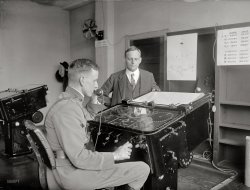
- Cornshucking Day Dinner: 1939
- September 1939. Granville County, North Carolina. "One of the Wilkins family making biscuits for dinner on cornshucking ... Posted by Dave - 08/07/2012 - 1:44am -
![Cornshucking Day Dinner: 1939 September 1939. Granville County, North Carolina. "One of the Wilkins family making biscuits for dinner on cornshucking day at Mrs. Fred Wilkins' home near Tallyho." Medium format negative by Marion Post Wolcott. View full size.
One Item menuMy grandfather was an expert vegetable grower although his occupation was a coal miner. On summer evenings in the days of victory gardens, he knew exactly when the corn was "ready", at its sweetest, most tender, out-of-this world apex, and he would say to Gram, "Put the water on to boil, I'll go pick the corn." It had to be picked immediately before cooking so the natural sugar would not run out and the kernels had no time to toughen. That would be our supper, ears and ears (all you can eat) of fresh, pearly, sunny ears of tender corn, with lots of homemade butter, very little salt. There has never been anything to compare with that flavor. My second favorite thing in the summer is a just-picked tomato sliced on a sandwich on white bread with only mayo, salt and pepper. It would have been easy to be a vegetarian with those flavors. No meat needed.
Just wonderingI cast my vote for less callipygian disclosure. But could I have one of those biscuits, please?
Jeanette WilkinsMrs. Wilkins was Jeanette Wilkins. She died in 1986 at the age of 91. Husband Fred died a few months later at the age of 93. Eat homemade biscuits and fresh corn and live longer.
LardFor long life, eat corn, biscuits, and Swift's Jewel Lard by the bucket.
Ceramic crocks, bucket, wash basin and soapThis is how I imagine my grandmother's kitchen before the well and pump were put in. The crocks with towels over the top were used in lieu of an icebox to keep things from spoiling. Somewhere, if you could look, you would find large bins for flour and sugar.
I know where I'm going for dinnerMmmm, Chicken & Dumplings
Baking Powder Biscuits
(from a 1933 Recipe)
Ingredients:
-- 2 cups sifted flour
-- 2 tsp. baking powder
-- 4 tablespoons butter or shortening
-- 1/2 tsp. salt
-- about 3/4 cup milk
Sift Flour once, measure, add baking powder and salt, and sift again. Cut in shortening or butter. (use your hands and rub the butter into the flour).
Add milk gradually, stirring until soft dough is formed. Turn out on slightly floured board and lightly "knead" for 30 seconds, enough to shape.
Roll 1/2 inch thick and cut with 2 inch floured biscuit cutter. Bake on ungreased sheet in a 400 degree oven for 12-15 minutes.
Makes 12 biscuits.
http://oldfashionedliving.com/biscuits.html
Things must have been betterBack then, folks ate lard, butter, real salt, pork, red meat and eggs, and lived into their 90s. Now with our modern diets of margarine, poly unsaturates, egg beaters, greaseless, fatless and tasteless stuff, folks are kicking off in their 40s and 50s. The old timers knew how to eat and live longer.
[You have it backwards. In the United States, median age at death (and life expectancy) increased steadily throughout the 20th century. - Dave]
Working WomanThere's something about a clean and orderly kitchen that speaks well of the woman. Shiny clean pots, flowers, a hat. Hat?
Ersatz LardThe Jewel shortening isn't really lard, as it is "made from vegetable and animal fats," a midway point between lard and Crisco.
Living longer...Farm folks who lived longer did so in spite of their diet and probably because they got lots of exercise working so hard, and were less stressed than their city counterparts. But living longer was more the exception than the rule even for rural people.
Many of my ancestors died young because they didn't have the money to call in a doctor when one was needed.
"Ain't seen a doctor since the day I was born... Ain't a'gonna call one, now."
Maybe what Jay meant to sayWas that back then, folks ate lard, butter, real salt, pork, red meat and eggs, and weren't obese.
And he would be right about that. The general level of fitness of the population earlier in the 20th century compared to today strikes me in photo after photo here on Shorpy. It's almost remarkable to find a single obese person in crowd photos prior to about 1960, whereas today they make up a significant percentage of any crowd photo.
The reasons for the increase in life expectancy during the 20th century are many and varied, but I don't think eating fewer (damn good) biscuits made with lard and Crisco had much to do with it.
Before my timeThe Whitehouse Vinegar bottle on the top shelf is a highly sought after collectible today. My grandmother never liked the electric stove and Grandpa liked his biscuits baked in the wood stove oven. Biscuits three times a day for 89 years. Granville County is my home.
Biscuits are tricky!Biscuits are like pie crust. The more you handle the dough, the tougher it gets. It's easy to make biscuits that turn out like hockey pucks if you handle them too much.
Sorry, but I still make my biscuits with leaf lard. I know it will probably kill me someday, but if you surrender all your vices to the god of longevity, I'm really sorry for you. You will live a long and desolate life, devoid of the pleasures that make that very life worth living.
(The Gallery, Kitchens etc., M.P. Wolcott)](https://www.shorpy.com/files/images/8c11154u.thumbnail.jpg)
- Person County: 1939
- ... Farm boy in the doorway of a tobacco barn. Person County, North Carolina. View full size. Photograph by Dorothea Lange.
Very serious ... Posted by Dave - 09/05/2012 - 2:56pm -
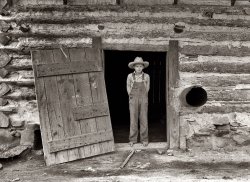
- Hendrick Motor Co.: 1928
- ... this dealership are any relation to the Hendrick family in North Carolina that runs several mega dealerships--and a rather successful NASCAR ... Posted by Dave - 09/04/2012 - 9:37pm -
![Hendrick Motor Co.: 1928 Takoma Park, Maryland, circa 1928. "Hendrick Motor Co., Carroll Avenue." National Photo Company Collection glass negative. View full size.
Fordor SedanThe new Model A Fords must have been painted on the building during the period that Ford was transitioning from the seriously outdated Model T, to the all new Model A. The Tudor Sedan shows a fresh air vent in the lower cowl. No production Model A ever had such a vent.
Legible signsI am struck by the bold, clear and legible use of typography in these older photographs. This is in distinction to the blur of pictograms, logos, and hen scratching that passes for public communications nowadays. Just look at the ads all around us. There was something deeply confident as well as respectful of potential customers embodied in our forefathers' use of graphics.
Model T SportscarAn interesting picture. I'd like to take a spin in a car featured on the sign, that Model T Coupe with the rumble seat.
[That's a Model A roadster. - Dave]
Radio DaysThe sign next to the service entrance says "batteries delivered to your home." That's because the majority of home radios in 1928 required a 6-volt lead acid battery to supply their tube filaments. Radios that ran on house current were just coming to market in 1928.
Takoma FordThis dealership later became Takoma Ford. Our family bought several cars from them because the service manager was a neighbor. The mechanical service area was through the big opening in the picture. To enter the body shop underneath you had to drive around the block.
It's a Sport CoupeThat would be a sport coupe... identified by the landau bars. The top does not fold down as it does on a roadster. Roadsters also did not have roll-up windows.
ObservationsObligatory "you can see the photographer in the reflection."
I wonder if this was a planned photo. You'd think they'd make an effort to clean up the lot.
Also, I'm surprised the barber shop didn't make it with all of the men having time to kill while their cars were being repaired.
Fordor ventsThe car on the right side of the sign is a Fordor rather than a Tudor. The early 1928 Fordors did indeed have cowl vents but they were eliminated shortly after introduction. I have a '28 leatherback Fordor like that.
Early 1928 SedanThe early 1928's did have a cowl vent on the lower driver's
cowl. These were called the "AR" model. The early cars had a number of changes in them, as discussed in the book "Henry's Lady" by Ray Miller. So it's an early 28. Thanks.
Cheap GasThe "Gasoline at D.C. Prices" sign is humorous--today it seems like gas gets cheaper the farther you get from urban areas (at least here in the NY/NJ/PA tri-state area); apparently that wasn't always the case.
I wonder if the founders of this dealership are any relation to the Hendrick family in North Carolina that runs several mega dealerships--and a rather successful NASCAR race team.
(The Gallery, Gas Stations, Natl Photo)](https://www.shorpy.com/files/images/33382u.thumbnail.jpg)
- Old House: 1939
- ... century. It represents the last gasp of Palladianism in North America. The lack of any rear ell or addition suggests it was designed ... Halifax County (currently for sale by Preservation North Carolina, seen here ).
The Macon House also appears at p. 90 in Johnston ... Posted by Dave - 08/30/2012 - 11:01am -
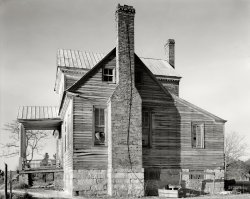
- Charleston: 1902
- Charleston, South Carolina, circa 1902. "Residence on Hasell Street." 8x10 inch dry plate glass ...
Charleston's Single Homes I was born just north of Charleston, and I remember my parents telling me that back in the day ... Posted by Dave - 07/20/2012 - 1:39pm -
![Charleston: 1902 Charleston, South Carolina, circa 1902. "Residence on Hasell Street." 8x10 inch dry plate glass negative, Detroit Publishing Company. View full size.
A Tree Grows in CharlestonI get it that the wooden ramp is to take your carriage out to the street, and the blocks on either side of that ramp are mounting blocks, to help you step in or out of that carriage. But I do not get the concept of planting trees in the curbs of the street. Is this some special tree with roots that only grow straight down?
Charleston TreesIf you will notice, the trees in the foreground are much older than the trees near the intersection. It appears that when the trees were first planted, there was a median between the sidewalk and the cobbled street (note the vertical cobbles). People were thinking "Green" before it became fashionable, after Al Gore invented the internet and global warming.
Trees in the StreetI think they figured they wanted shade trees. They didn't want them in the middle of the street and they didn't want them in the middle of the sidewalk. The curb was a compromise location.
So you aren't likely to bump into a tree...Perhaps the older trees were there before the sidewalk, and the latter created to accommodate the former. New trees would then be placed in line with the old. I dob't think the nature of the roots was a determining factor.
Turnbuckle Stars!I love turnbuckle stars!
Single HousesThis street has many fine examples of a residential style unique to Charleston, the single house -- one room deep with two-story porch ("piazza") on the side that catches the prevailing breeze. You enter through the piazza, not directly from the street. Single houses were built in Charleston from the second half of the 18th century through the end of the 19th, and devotees of New Urbanism are building new ones today.
Charleston architectureHope I'm not telling everyone things they already know here:
The single house style previously mentioned is a feature I love down here (I live right outside Charleston). Property owners used to be taxed according to how much of their house lined the street--the more house footage on the street, the higher the taxes. To beat the system, they started building houses one-room deep on the street. The result is streets full of narrow, deep houses which seem almost set on their side.
Those turnbuckle stars are actually the end of bolts that run all the way through the house from one side to the other. Charleston has frequent mini-tremors, and those bolts are designed to help keep the houses from falling apart. They were also used for added support during hurricanes and other storms. I don't know if turnbuckle stars are always used for those purposes, but down here that's why they show up in many buildings.
[They were generally used to keep brick facades from bulging out and separating from the frame of a building. There are many to be seen in our Washington, D.C., photos. - Dave]
Charleston's Single HomesI was born just north of Charleston, and I remember my parents telling me that back in the day houses in Charleston were taxed based on "road frontage" and the number of rooms.
Consequently, homes were built with the "front" facing the house next door, as narrow as comfortably possible, and without closets. Folks had furniture - wardrobe closets or armoires instead of closets in the bedrooms instead.
SerendipityBetween many of the beautiful Charleston homes are equally impressive courtyards and many secluded alleys with ferns and moss-covered walls, along with an abundance of hostas and other plants. Most alleyways are public thoroughfares and offer a welcome reprieve from summer heat, as well as affording a moment of quiet for meditation or romance. I always treasure evening walks around Charleston in the spring and fall.
No wonder so many people who come to visit Charleston end up moving here.
+10839 and 41 Hasell (pronounced "HAZEL") Street are still there and in great shape (as are many of the other homes on the street). They're located just east of Anson Street on the south side. Below is a similar (not identical but close) perspective from May of 2010.
Turnbuckles I live in Charleston and love history facts like this. These were part of what were called earthquake bolts. Since the 7.2 earthquake of 1886 damaged approx. 90 percent of the structures in and around Charleston, these were designed in rebuilt homes to hopefully hold the building and walls together in the case of another quake. Many areas of Charleston are on fill land so that does not help either for some houses in certain areas.These go from one end of the house to the other and There are decorative ends like these stars and some are just plain round or square metal plates. Thankfully they have not had to be tested.
As for Taxes way back then, Charleston also had a "door tax". Many of the older houses have huge windows that were almost floor to ceiling. In some of the main rooms, you could lift up the bottom part of the window and it would also serve as a door. Since it was not technically a "door" it was not taxable. It also served and good ventilation on hot summer days.
TreesThe trees were likely planted before the street was paved. The sidewalks in Charleston were often paved so that people could walk without getting muddy, before the streets were paved. Trees for shade were planted in the street and when the street was paved, the trees were left in place.
(The Gallery, Charleston, DPC, W.H. Jackson)](https://www.shorpy.com/files/images/4a09475a.thumbnail.jpg)
- Chain Gang: 1910
- ... convicts engaged in road work, Autumn 1910. Pitt County, North Carolina. The inmates are quartered in the wagons, which are equipped with ... Posted by Dave - 09/07/2011 - 7:57pm -
![Chain Gang: 1910 Chain gang of convicts engaged in road work, Autumn 1910. Pitt County, North Carolina. The inmates are quartered in the wagons, which are equipped with bunks and move from place to place as labor is utilized. The central figure is J.Z. McLawhon, county superintendent of chain gangs. The dogs are bloodhounds used for running down any attempted escapes. View full size.
Chain Gang'Nuff to give ya'll the blues!
Chain GangI especially enjoy the Cream of Wheat guy next to the guitar player.
Pitt County, NCThis website is so neat, I live in Pitt County, NC. It's interesting to see all these old pictures.
Skip JamesI do believe that's famous bluesman Skip James on guitar over there.
[Skip James was 8 years old in 1910. - Dave]
Skip JamesI have a compilation of Skip James & Son House music entitled "Hard Time Killin' Floor" and this photo is featured on the cd cover. It was issued by Yazoo Records, which I thought usually does a good job on research regarding the music.
I'm a little disappointed (in Yazoo) to learn that this has no direct relevance to either of their lives besides illustrating the general plight of rural black Southerners.
I suppose evoking that atmosphere was the intention, but it just seems too specific and documentary in nature to be used when it's apparently not even contemporary with the music on the disc.
(The Gallery, Dogs, Rural America)](https://www.shorpy.com/files/images/8e04044u.thumbnail.jpg)
- Fayetteville at Five: 1941
- ... March 1941. "Traffic on the main street of Fayetteville, North Carolina, at about five o'clock, when the workers start coming out of Fort ... Posted by Dave - 10/04/2021 - 1:13pm -
![Fayetteville at Five: 1941 March 1941. "Traffic on the main street of Fayetteville, North Carolina, at about five o'clock, when the workers start coming out of Fort Bragg." Photo by Jack Delano. View full size.
What's he standing on?Is what he's standing on still there?
[Planet Earth? Last we checked, yes. - Dave]
Twist of FayettevilleThere have been a lot of changes in downtown Fayetteville. This looks approximately right - Rayless department store was at 200 Hay St. There is no more parking, and the street has been narrowed with many trees planted. I can spot at least 3 surviving buildings on the right, including the old McFadyen Music.
It looks like the original photo was taken from the balcony of the Market House. You can see it in street view if you swivel 180 degrees.
Is that a Lincoln?The fifth car back on the left, the light-colored one. I need help from the Shorpy auto buffs.
I have lived here since the 70sYes, he will have been standing on the west balcony of the Market House, it was recently in the news due to an attempted arson during the riots last summer. The debate is still open as to what should be done with it, tear it down, move it, or?
I remember many of the buildings in the picture, many started going away by the late 70s and early 80s as the downtown area fell apart and shopping moved out to the malls. Quite a few of the buildings are still there but heavily renovated. The Hotel Lafayette is long gone, The Prince Charles is still there and is currently housing rental condos and small businesses. Downtown has come, gone, and come again.
My guess is ChryslerI'm thinking this is a 41 Chrysler Series 30 Eight
5th car on leftI don't believe so. The Continental had a different trunk lid and rubber mudguard on the front of the rear fender, and the Zephyr rear was more sloped. Could be wrong though.
5 p.m. Fort Bragg exodus?I lived on Fort Bragg when my dad was stationed there in the early '60s and it's highly unlikely any end-of-the-day traffic from the post would be noticed in downtown Fayetteville 13 miles away.
[Fayetteville was home to thousands of construction workers engaged in a massive wartime expansion of Fort Bragg -- the reason this series of photos was made. - Dave]
No, it's not a LincolnThe shape of the rear fender, the three horizontal ribs, and the location of the filler cap leave no room for guessing – it's a 1941 Plymouth P12 Special Deluxe.
McFayden MusicI was a little surprised to find out that McFayden Music is still in business, though now they are in Greenville, according to their website!
Fayetteville Street LifeI suppose the trees planted along the sidewalk in present-day Fayetteville are nice, and I know there is an anti-automobile sentiment in many towns, large and small, that results in limited street parking, narrower roads, bike lanes, pedestrian priority rights-of-way, etc. But I can't help but notice the vibrancy of street life in Fayetteville back in 1941. The streets are lined with shops, and there is exuberant signage everywhere. There are actual pedestrians - shoppers, workers, people running errands - walking on the sidewalks. The street is bustling with traffic. Today? It looks kind of quiet and desolate - although I bet the local shopping mall and the Wal-Mart and the Home Depot out by the Interstate are full of consumers.
(The Gallery, Cars, Trucks, Buses, Jack Delano, Stores & Markets)](https://www.shorpy.com/files/images/SHORPY-8c04841a.thumbnail.jpg)
- Mother Caroline: 1939
- July 1939. Orange County, North Carolina. "Caroline Atwater, wife of Negro landholder, in the yard of her ... This is Joe Manning. According to census records, and to North Carolina records, Caroline Atwater was born about 1865, and died in 1949. ... Posted by Dave - 01/19/2008 - 12:47am -
![Mother Caroline: 1939 July 1939. Orange County, North Carolina. "Caroline Atwater, wife of Negro landholder, in the yard of her double one-and-a-half-story log house, telling where she was born and how she came to this place." View full size. Medium-format nitrate negative by Dorothea Lange for the Farm Security Administration.
Well?Is she standing by a well?
[Well, yes. - Dave]
You have gotten my curiosityAnd where might we find her story?
[See above. - Dave]
Mother Caroline: 1939This is Joe Manning. According to census records, and to North Carolina records, Caroline Atwater was born about 1865, and died in 1949. She was married to Ennis Atwater. She apparently lived her whole life in North Carolina. She had at least two children, both boys: Jesse, who was born about 1894, and died in 1948; and Philip, who was born about 1907, and died in 1930.
[Thanks, Joe. I have one or two more photos of her to post. - Dave]
TeaHer face bears the lines of a harrowing journey. I'd love to just sit and have tea and listen to her talk all day.
CarolineShe seems to have lived a long life, but to have outlived her two boys....hope she had grandchildren or some other family. She seems so lonely.
Caroline AtwaterSamuel Snipes and Tempy Atwater (see the 1880 Chatham census) were from that same area, Lambsville near Chapel Hill. I am also related to the white James Dowdy family from Gulf, N.C., and black Lamberts, Snipes, Rives/Reaves Dowdy families. If you have any info please contact me at 314/249-8972 or at MDGrant@Webtv.net. Thank you.
Madeleine Snipes Grant
(The Gallery, Dorothea Lange, Rural America)](https://www.shorpy.com/files/images/8b33823u1.thumbnail.jpg)
- Second Graders: 1962
- ... kid, wise beyond her years
Simply Adorable!
North & South In the spring of 1962, I was in fourth grade. Since I was ... at Tarawa Terrace Elementary School, Camp LeJeune, North Carolina. My class also included children of a wide variety of skin colors. ... Posted by aenthal - 12/03/2016 - 2:52pm -
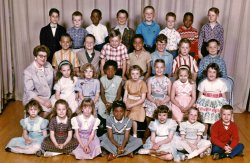
- Zollie Lyons: 1939
- ... wife and part of his family. Note dog run. Wake County, North Carolina." View full size. Medium-format nitrate negative by Dorothea ... Posted by Dave - 03/10/2009 - 12:23pm -
![Zollie Lyons: 1939 July 1939. "Zollie Lyons, Negro sharecropper, home from the field for dinner at noontime, with his wife and part of his family. Note dog run. Wake County, North Carolina." View full size. Medium-format nitrate negative by Dorothea Lange.
They all look so tired....Life must not have been too easy back then.
Dog run?What dog run?
[Reference to a southern style of architecture. - Dave]
Re: Dog RunOne purpose of the dog run was to serve as a sort of firebreak. The kitchen was on one side. If a fire broke out there, perhaps the rest of the structure could be saved.
The Lyonses It would be interesting to know what the war did to this family; the years of Southern sharecropping were drawing to a close, and the war could have provided work in factories in the Northern cities.
Additional reading If one wanted to get a real sense of how life was for sharecroppers in the South during the Depression, I can suggest a novel called "Hold Autumn in Your Hand" by George Sessions Perry. I don't know if the book is in print, but used copies are probably at Amazon. I stayed up all night to finish this one.
A good non-fiction work about sharecropping in the South is called "The White Scourge: Mexicans, Blacks, and Poor Whites in Texas Cotton Culture" by Neil Foley. A tough read, but mixed amongst the first-person narratives is a good explanation of the financial aspects of sharecropping, for both the sharecroppers and the owners.
[Thanks for the suggestions. I'd like to throw in a mention for the short stories of Flannery O'Connor. - Dave]
Dog TrotThese cabins, called "dog trots," were found throughout the cotton South, having originated in Appalachia. They featured a center hallway between two "pens" or buildings, where much of the domestic work of the house such as cooking, washing, and food preparation could be done in the shade or out of the rain. Also, ventilation was provided by the center opening. Here is an extensive photo documentation of one of the houses - much like the one pictured here: http://www.greatbuildings.com/buildings/Dogtrot_House.html
Dog run = dog trotThe "dog run" or "dog trot" is the center opening. A lot of Southern homes had a kitchen separate from the main living area, to keep the living area cool. Sometimes homes had a completely separate building known as a "summer kitchen" where cooking, canning, clothes washing etc could be carried on without heating up the house, & also to prevent any fires from burning the main house down. My dad (age 87) says southern men also used to keep a mirror, pitcher & basin, soap, razor, etc on the back porch, so they could wash up & shave out there.
We are the desendantsCommenting on one of the articles The Lyonses- wondering what happened to the family after the war. It was amazing to see our great- grandfather Zollie Lyons on these pictures! How can we get more information? I didn't know that these pictures existed. The family still resides in North Carolina. Please advise of who we can contact for more information.
[This and other photos from this set at the Library of Congress can be found here. -tterrace]
(The Gallery, Dorothea Lange, Rural America)](https://www.shorpy.com/files/images/8b33814u1_0.thumbnail.jpg)
- Ashes by Now: 1865
- 1865. "Charleston, South Carolina, after the Bombardment. Ruins of the Cathedral of St. John and St. ... one said he did. However, his overland approach from the north led to the evacuation of the city in February 1865. - Dave]
(The ... Posted by Dave - 08/02/2012 - 8:37am -
![Ashes by Now: 1865 1865. "Charleston, South Carolina, after the Bombardment. Ruins of the Cathedral of St. John and St. Finbar." The city after shelling by the Federal Navy and the approach of Sherman's troops. Wet plate glass negative. View full size.
Then and NowThe Cathedral of St. John is a thriving part of modern-day Charleston. The attached photo shows the current structure, which follows along the same lines of architecture. The church is currently installing a bell tower and undergoing other renovations. Their website tracking the restoration is http://www.stjohnthebaptistcathedralrestoration.com/
I'm lovin' itApparently Charleston had at least one McDonald's restaurant as far back as the mid-19th Century.
Double TroubleThe Cathedral of St. John and St. Finbar, consecrated in 1854, was already in ruins by the time of the Federal bombardment. On December 11, 1861, a fire that began in a factory on Hasell Street destroyed much of Charleston, including the cathedral. The subsequent fundraising campaign for a new cathedral lasted 45 years, and the cornerstone for the present Cathedral of St. John the Baptist was laid in 1890. It is built on the foundation of the 1854 church.
Making the rubble bounceThese churches, along with the Circular Church (seen in some of the other Charleston photos here), were being rebuilt after the fire of 1861. Needless to say, work was interrupted by the naval bombardment, and reconstruction had to wait until Reconstruction.
Sherman did not go to Charleston.Sherman's troops did not go to Charleston!
[No one said he did. However, his overland approach from the north led to the evacuation of the city in February 1865. - Dave]
(The Gallery, Charleston, Civil War)](https://www.shorpy.com/files/images/SHORPY_02394a.thumbnail.jpg)
- Class Photo: 1900
- ... we had one, regardless of color. And, having lived in the North and West, too, I didn't see much difference in how the kids acted in ... parents even though my mother had been raised in North Carolina. Once on a visit to her mother and sister while they went into a store ... Posted by Dave - 02/22/2016 - 1:06pm -
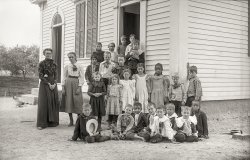
- Kids' Table: 1966
- ... in my mother's newly remodeled kitchen in Mount Airy, North Carolina. I'm the girl on the right. It's either Thanksgiving or Christmas ... Posted by PJMoore - 02/16/2009 - 4:58pm -
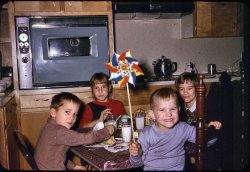
- How to Swim: 1913
- ... apples off the tree" hand stroke.
At the University of North Carolina in the mid 1960's, you had to pass a swimming test (four laps of the ... Posted by Dave - 06/09/2018 - 4:21pm -
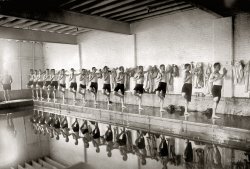
- iTunes: 1939
- ... versa (let's hope).
Strung Out The University of North Carolina Libraries have some interesting details about Tobacco Bag Stringing ... Posted by Dave - 09/05/2012 - 7:09pm -
![iTunes: 1939 April 1939. "White migrant strawberry picker playing guitar in his tent near Hammond, Louisiana." Safety negative by Russell Lee. View full size.
Germ Processed Motor OilConoco developed a process for making motor oil from corn "germ" (hypocotyl) back in the early 1930s.
Sign of the timesFunny how they felt it was necessary to point out that he is white.
Well, on second thoughtMaybe he was picking white migrant strawberries.
Bringing bad luckI don't know if I just have strange relatives (well yes I do, but I digress) or if it is a common superstition, but as far back as I can remember, we were warned NEVER to place a hat on a bed because a hat on a bed was a sign of impending death to someone close to you. Whenever I mention that today, people think I'm crazy (well maybe I am, but aren't we all?). Its a lot like breaking a mirror but worse.
[You and Matt Dillon. - Dave]
Castrol etc."Germ-Processed" motor oil came from castor beans, not corn, and was paraffin based. Castrol (a contraction of "castor oil") was one such product.
In his pocketI'm trying to figure out what is in his pocket, and is it attached to that string?
[A pack of cigarettes. I recall having this discussion earlier about a different guitar player, but can't find it in the comments. Help! - Dave]
That rolling pinmay explain the shoes. Or vice versa (let's hope).
Strung OutThe University of North Carolina Libraries have some interesting details about Tobacco Bag Stringing.
Not Just a MoviePerhaps a packet of rolling tobacco?
Completely fascinatedIt's like looking into a frozen moment in time in every detail. Extremely fascinating as all these images are. What is funny is to read the comments and how people tend to post flippant comments with absolutely no concept of perspective the time period and the situation. I see a young man living in a tent enjoying a short respite away from the rigor of hard work and poverty in extreme focus. Pointing out that he is a white migrant strawberry picker is not different if he were black and the title read black migrant strawberry picker. The moment, circumstance and situation would remain the same. So much detail and oddly enough beauty caught in one frame. It is amazing to me.
(The Gallery, Agriculture, Music, Russell Lee)](https://www.shorpy.com/files/images/8b21509u.thumbnail.jpg)
- Plastic n Plywood: 1942
- ... and shifted its CT operations to facilities in Ireland and North Carolina.
Boom This instantly reminded me of one of those "typical" ... Posted by Dave - 02/20/2012 - 4:10pm -
![Plastic n Plywood: 1942 January 1942. Bantam, Connecticut. "Defense homes. Fred Heath works on the night shift at the Warren McArthur plant in Bantam, and spends his days with Mrs. Heath and their three-year-old daughter, Ann. Here they are in the living room of the Heaths' new four-room apartment, part of the new eighty-unit defense housing project just five minutes walk from the plant. The Heaths, who pay thirty dollars rent, like overstuffed chairs, and Ann also likes her overstuffed Teddy Bear." 4x5 nitrate negative by Howard Hollem. View full size.
RentUsing the inflation calculator the equivalent rent today would be $435/mo. I wonder what the dad's salary equivalent today is.
Cushy job?Of course they liked the overstuffed chairs. The Warren McArthur plant in Bantam made upholstered seating for bombers and other planes. Its name changed many times following the war, from Warren McArthur to Aerotherm Corp., to Aerotec Industries, UOP Aerospace Division, PTC Aerospace, and finally, in 1992, B/E Aerospace. It closed its Bantam operations in 2002, and shifted its CT operations to facilities in Ireland and North Carolina.
BoomThis instantly reminded me of one of those "typical" rooms the military had set up in the blast range during the atomic bomb tests in the 50's.
Re: RentI have no idea what this dad's salary was, but last week while touring the Glenn L. Martin Aviation Museum here in Baltimore, I noticed in a display case a 1944 "New Employee" info card, for unskilled labor. His starting hourly wage was 60 cents an hour = about $5.50 today.
Cute little Anndoesn't care that the walls are plywood!
Idle chatterIn the context of the photo I know why the overstuffed chair thing is relevant, but when I read the caption it seemed like such an odd thing to say about a family. You can almost imagine one of the neighbors: "Oh, the Heaths? Nice folks. They sure like their overstuffed chairs, those kids do."
Nice to knowI am wondering if little Ann would remember this? She would be 72 now, so maybe she is still alive. Would one of our many genealogy researchers like to find out?
DiplomaI am guessing that it is the mother's high school diploma from Torrington HS in Connecticut that is on the wall. Her first name appears to be Mary but I cannot make out the last name or year. The last name does not appear to be Heath. If we could enlarge that section we might have her maiden name and a good guess on her age for the genealogy folks to use.
Some time back I was able to download the large tiff files from the LOC and view them, but I don't remember how I did it. Can someone help me out.
[The link to the tiff is on this page. - tterrace]
Mary Giarneseb. 12/27/1922
d. 08/23/2000
Radiators and ply wood wallsHow strange that there are still homes who use those radiators today. I have heard that they are in homes all over NYC. I don't remember ever seeing a home with ply wood walls.
Like a childHer Daddy is her biggest Hero.you can see it in her smile.
Where The Heaths Live Here's a shot of a wintertime, ice and snow covered street in the business district of the town where the Heaths have taken up residence while Mr. Heath works for Warren McArthur.
(The Gallery, Howard Hollem, WW2)](https://www.shorpy.com/files/images/SHORPY_8e10822u.thumbnail.jpg)
- St. Michael's Episcopal, Charleston: 1865
- ... St. Michael's Episcopal Church in Charleston, South Carolina, in 1865 following bombardment of the city during the Civil War. From ... left in the South over the Total War strategy waged by the North against civilian centers in Virginia, Georgia, South Carolina and other ... Posted by Dave - 06/16/2011 - 2:15am -
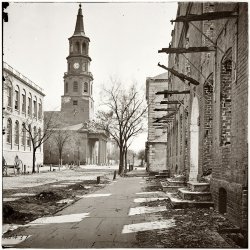
- Kitty Hawk: 1901
- 1901. Kitty Hawk, North Carolina. Wilbur Wright and glider just after landing. 4x5 dry-plate glass ... Posted by Dave - 12/13/2007 - 6:55pm -
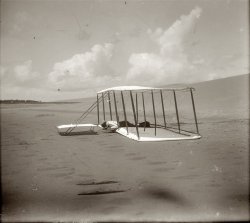
- Life Savers: 1908
- ... station that used this technique, Chicamacomico in North Carolina, still gives regular demonstrations. Unfortunately they're out of ... Posted by Dave - 08/21/2012 - 5:54pm -
